What you see below is the Duo-Touch II rugged slate computer from General Dynamics Itronix that measures 10.6 x 7.2 inches — significantly smaller than a standard sheet of paper — and weighs barely more than four pounds. The picture was taken outside on a bright day and yet you can clearly see and read the display thanks to advanced "DynaVue" display technology. Why is it called the Duo-Touch? Because this is a Tablet PC that has both a touch screen and high resolution digitizer for use with a pen. We show the computer sitting outside in the dirt because it is a tough, rugged machine that can take a beating.
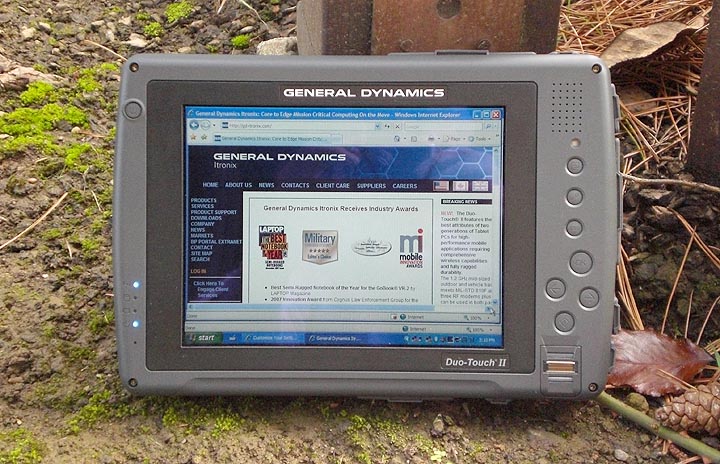
Where the Duo-Touch II fits in
The Duo-Touch is part of the General Dynamic Itronix lineup of rugged mobile computers that also includes the high-performance GoBook XR-1, the semi-rugged GoBook VR-2 — both full-size notebooks — and the ultra-mobile GoBook MR-1. The Duo-Touch II is designed for field applications where the computer is carried around and a clamshell design with a full keyboard is neither feasible nor necessary.
Unlike consumer market laptops that change all the time, computers designed for commercial and industrial markets and the government have a much longer product life. If a design is right, it may remain visually unchanged for several years so that customers do not have to constantly replace peripherals, docks, mounting systems, and retrain people.
The Duo-Touch is essentially a third or forth generation design. We first saw the machine back in 2003 when Twinhead, one of Taiwan's premier notebook makers, introduced it as perhaps the first rugged Tablet PC. Towards the end of 2003, Itronix adopted a second generation version of it and named it the GoBook Tablet PC. Itronix had a long-standing relationship with Twinhead and so a much improved third generation machine was developed in close cooperation between the two companies. This became the first GoBook Duo-Touch, a serious slate computer for vertical market applications. Outside, the Duo-Touch didn't look very different from its predecessor, but inside it was a design revelation that we called "one of the toughest, cleanest computer bodies ever made" in a 2005 review.
There wasn't any reason to change the overall concept of the third generation machine, but technology moves on, especially in the processor and storage department. GD-Itronix addressed this in the fourth generation Duo-Touch II, and also upgraded the machine in other areas.
So here is the 411 on the Duo-Touch II: It's a rugged tablet computer measuring 10.6" x 7.2" x 1.65" and weighing just over four pounds. It has a sunlight-readable 8.4-inch 800 x 600 pixel display, runs either the Windows XP Tablet PC Edition or Windows Vista, and has both a PC Card and a CF Card slot. There are two USB 2.0 ports, audio in/out jacks, a RJ45 LAN connector, and a RJ11 modem jack. All ports are sealed with rubber plugs, and you can get integrated GPS and just about any wireless option you want.
Significantly higher performance
Under the hood, the Intel Pentium M 733 CPU of the prior generation machine has been replaced with a 1.2GHz Intel Core Duo Processor U2500. This ultra low-voltage chip has a faster frontside bus and two processing cores. It is rated at a Thermal Design Power (or TDP) of 9 Watts, with TDP defined as the maximum amount of power the cooling system of the computer must dissipate. The older M 733 processor was also an ultra-low voltage design and drew even less power (about 5 Watts), but the performance difference is dramatic. We installed Passmark Software's PerformanceTest 6.1 both on the new Duo-Touch II and a 3rd generation model with the older M 733 processor. PerformanceTest 6.1 runs about 30 tests covering CPU, 2D graphics, 3D graphics, memory, and disk and then computes scores for each category and an overall PassMark score. Both machines ran Windows XP Tablet PC Edition. Here are the results:
|
PERFORMANCE COMPARISON
|
Duo-Touch II (U2500)
|
Duo-Touch (M 733)
|
Increase (%)
|
|
CPU Mark
|
631.0
|
278.2
|
126.8%
|
|
2D Graphics Mark
|
164.4
|
155.9
|
5.5%
|
|
Memory Mark
|
240.6
|
215.4
|
11.7%
|
|
Disk Mark
|
318.8
|
227.6
|
40.1%
|
|
3D Graphics Mark
|
101.4
|
75.9
|
33.6%
|
|
Overall PassMark
|
312.6
|
190.3
|
64.3%
|
The new machine was faster in every test, and often substantially so. The Core Duo processor ran through the CPU tests more than twice as fast, and the overall performance index was up by almost two thirds. This is a remarkable difference and very noticeable.
Daylight viewable display
Mobile vertical market computers like the GD-Itronix Duo-Touch II are often used outdoors. This means the display must be readable in broad daylight. The pursuit of outdoor readability has been sort of a Holy Grail of rugged computer manufacturer and different technologies have been tried over the years. While one might think that display brightness is the key, brightness alone is not enough. The real problem is reflection. If the amount of light reflected by the display is as much or more than the light emitted by the backlight, then the display cannot be read. So contrast becomes an issue.
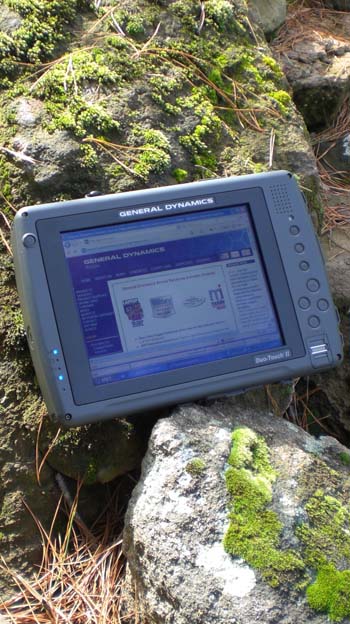 LCD manufacturers define contrast ratio as the ratio between the whitest pixel and the blackest pixel in a dark room. Such ratios can be 1000:1 or more. They are also meaningless outdoors. According to our technology editor Geoff Walker, the real-world, or effective, contrast ratio outdoors can be determined with a rule-of-thumb formula where effective contrast ratio = 1 + (emitted light / reflected light). Effective contrast ratios are generally between 1:1, which is unreadable, and 20:1 which is as good as it can get and comparable to a typical newspaper in sunlight.
LCD manufacturers define contrast ratio as the ratio between the whitest pixel and the blackest pixel in a dark room. Such ratios can be 1000:1 or more. They are also meaningless outdoors. According to our technology editor Geoff Walker, the real-world, or effective, contrast ratio outdoors can be determined with a rule-of-thumb formula where effective contrast ratio = 1 + (emitted light / reflected light). Effective contrast ratios are generally between 1:1, which is unreadable, and 20:1 which is as good as it can get and comparable to a typical newspaper in sunlight.
Emitted light — the strength of the backlight — is important but it is also a mixed blessing. It is generally measured in candela per meter squared and usually called "nits." Average notebook backlights are about 200 nits. A "high bright" display may have as much as 1,000 nits. This draws a lot of power and can wash out pixels, making even dark ones look grayish.
The key to a daylight readable display therefore is in reducing reflection. That is relatively simple for a standard LCD, but much more difficult for displays with touch screens as they add more layers and thus more reflective surfaces. To reduce reflection, manufacturers use anti-reflective coatings and special polarizers. The exact layering and bonding methods of all those surfaces determines overall reflection, and this is where the patent-pending >GD-Itronix DynaVue technology comes into play. In conjunction with a strong (but not excessively bright so as to significantly reduce battery life) backlight, it cuts overall display reflectivity to about 7:1, which Walker describes as "adequately readable in sunlight."
How does it work in the real world? Remarkably well unless you have unrealistic expectations. Take the Duo-Touch outdoors on a bright day, and it remains totally readable in the shade. Go into direct sunlight and it becomes a bit more difficult as the sun can still reflect in the display surface. So why not add one of those matte-looking anti-glare coatings on top of everything else? Because GD-Itronix found that an anti-glare coating reduced performance and test users felt an anti-glare coated screen was not as sharp. As is, even facing the sun the screen remains readable, though you may have to position it so there is no direct reflection from the sun.
Is the display perfect? No, and current technology doesn't allow one that is, at least not outdoors. Compared to competing technologies, the DynaVue approach matched or exceeded anything we've seen here at RuggedPCReview.com. Indoors we noticed a faint horizontal line pattern and grid, and a bit of optical distortion when viewing the display from an angle.
What about the viewing angle? Ever since the BOE Hydis wide viewing angle LCDs became available in Tablet PCs, we've been raving about them as they let you view the screen from any angle without any color shifts or washing out. Well, BOE Hydis does not make an 8.4-inch display. The one GD-Itronix uses has a perfect near-180-degree horizontal viewing angle, but a much narrower one when you tilt the unit vertically. That means you have to hold the computer at a proper angle to avoid color shifts. This would be an issue in a notebook, but much less so in a tablet that can easily be positioned for best possible viewing.
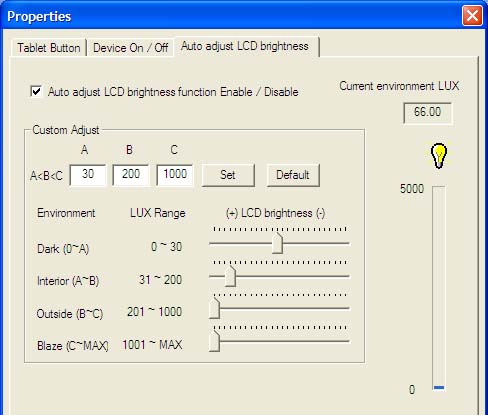 Brightness adjustment is either automatic or via buttons. The manual mode isn't immediately obvious: You use Function and the "rotate" key to increase brightness, and Function and the "security" key to decrease it.
Brightness adjustment is either automatic or via buttons. The manual mode isn't immediately obvious: You use Function and the "rotate" key to increase brightness, and Function and the "security" key to decrease it.
In automatic mode there is the very handy control panel shown to the left. It lets you set backlight brightness levels in response to ambient lighting conditions as measured by the computer's light sensor that sits on the right side of the screen just above the control buttons.
The light sensor measures light in lux. Direct sunlight ranges from 30,000 to 100,000 lux. Outdoors in the shade you may encounter a few hundred to a couple of thousand lux. Indoors, you may have as little as 30 lux or as much as 500 under a bright reading lamp. The panel lets you set automatic brightness for four ranges. When the sensor detects a different lighting environment, it waits a few seconds, then adjusts brightness in steps. Even if you set the brightness to maximum for all levels, it's educational to watch the lux readout. You learn something about lighting intensity.
The same utility also lets you assign alternate functions to each of the hardware buttons to the right of the LCD.
Dual digitizers
Like its predecessor, the Duo-Touch II has a dual-mode digitizer. It can work as an active digitizer as required for the full Windows XP Tablet PC Edition and Vista pen functionality, but it can also work as a passive touch panel. In active mode it provides cursor tracking, right mouse-click emulation (pressing and holding the pen until the right mouseclick menu pops up) and all the other neat tricks an active digitizer can do. In passive touchscreen mode it works like a PDA and you can use any stylus or finger to tap the display. In touchscreen mode, the digitizer is responsive, but also offers excellent palm rejection. Palm rejection refers to the digitizer's resistance to making the cursor jump when you inadvertently touch the screen with the palm of your hand. To toggle between the two modes, you press the left and right buttons at the same time. This, again, is not obvious, but once you figured it out, you won't forget.
The dual-mode digitizer definitely adds flexibility to the machine. When doing standard Windows chores, the digitizer pen works best, but some custom software applications may be designed for mobile use and you simply use your fingers to operate it.
The touch screen can be calibrated and configured via a special and quite extensive control panel. Spend some time with it to optimize the touch screen to your personal preferences. The difference can be amazing.
Two criticisms we had with the predecessor model have not been addressed. First, after all these years, the Wacom active digitizer has some quirks. No matter how I calibrated it, the cursor would become imprecise near the bottom and right side of the display. Apparently this is difficult to fix, and especially so with a display where a touch screen and thick protective glass increase the distance to the Wacom digitizer behind the LCD. If the display surface is level with the front bezel of the computer, as is the case with some Tablet PCs, you can compensate by overshooting the edge of the actual display, but on the Duo-Touch II the display is recessed into the magnesium bezel by about 1/8th of an inch and so you bump into it when you try to manipulate the cursor near the edges.
Still, the dual-mode digitizer makes the computer more flexible in every respect, and the active digitizer flaws I mentioned are present in almost all Tablet PCs to some degree.
Sound structural design
 In 1981, author Tracy Kidder wrote a landmark book entitled Soul of a New Machine in which he chronicled the development of a Data General supermini computer. If the GD-Itronix Duo-Touch II has a soul, it is evident in the incredible engineering effort that went into creating its insides. Remove the two large sealed magnesium covers at the bottom of the Duo-Touch II and you see what remains one of the toughest, cleanest computer chassis ever made. It's evident that every small detail has been thought through. And everything inside is as beautifully designed and finished as any part outside. That's in stark contrast to the sloppy messes we've found inside many rugged machines over the years.
In 1981, author Tracy Kidder wrote a landmark book entitled Soul of a New Machine in which he chronicled the development of a Data General supermini computer. If the GD-Itronix Duo-Touch II has a soul, it is evident in the incredible engineering effort that went into creating its insides. Remove the two large sealed magnesium covers at the bottom of the Duo-Touch II and you see what remains one of the toughest, cleanest computer chassis ever made. It's evident that every small detail has been thought through. And everything inside is as beautifully designed and finished as any part outside. That's in stark contrast to the sloppy messes we've found inside many rugged machines over the years.
On the bottom left in the picture you can see the 80 GB 5400 rpm Hitachi SATA hard drive that's shockmounted via 5mm neoprene strips in its own metal enclosure. A heating patch sits on the spindle area, allowing the disk to boot and operate at temperatures as low as -4 degrees Fahrenheit. I should mention that a 120 GB disk is available as are solid state disks with current capacities of either 16 or32GB. Solid state disks cost more but generally have a mean time between failure about six times longer than conventional hard disks. They also boot quicker, data access is much faster, they are silent, and battery life is generally about 10% longer.
Despite its low voltage design, the Intel Core Duo processor does need cooling, but since a conventional fan is out of the question in an IP54-sealed machine, the Duo-Touch II has a fan and heat exchanger that sit in a special compartment which is open to the outside but sealed to the inside. This way water may get into the fan compartment, but the fan can handle it. It even runs underwater.
All ports and openings along the side are sealed with individual plastic covers with rubber seals. Each cover is screwed onto the body, so if it ever breaks you can simply replace it with a new one. Large openings like the PC Card and CF Card slots also have threaded holes on either side. They are there so that those slots can be sealed with screw-down covers if there is no need to open them.
Approach to battery life
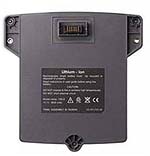 One of the trade-offs in mobile computing is weight versus battery life. A larger battery provides longer operating time between charges, but at the cost of higher weight. GD-Itronix decided on a compromise: the Duo-Touch II has a 11.1 Volt, 3,900 mAH 43 watt-hour internal battery that weighs 11.2 ounces and is good for 2.5 to 3.5 hours depending on use. It neatly fits into the top compartment shown on the picture above.
One of the trade-offs in mobile computing is weight versus battery life. A larger battery provides longer operating time between charges, but at the cost of higher weight. GD-Itronix decided on a compromise: the Duo-Touch II has a 11.1 Volt, 3,900 mAH 43 watt-hour internal battery that weighs 11.2 ounces and is good for 2.5 to 3.5 hours depending on use. It neatly fits into the top compartment shown on the picture above.
If extra battery life is needed, GD-Itronix offers an expansion battery (US$159; shown on the right) with another 43 watt-hours that snaps onto a sealed battery expansion port where it is secured with screws. This effectively doubles battery capacity. An alternate would have been to simply equip the Duo-Touch II with a larger battery, but that would have added about half a pound of weight between the bigger battery and the larger cover. This way, customers can choose between lowest possible weight and acceptable battery life, or an extra half pound of weight and twice the battery life.
Environmental specs
The GD-Itronix is a fully rugged computer. It is able to operate within a very wide temperature range of -4 to 140 degree Fahrenheit. It has been tested in accordance with the method described in MIL-STD-810F Method 516.5 Procedure IV, commonly known as the "drop spec." The Duo-Touch II survived a total of 26 drops on each face, edge and corner.
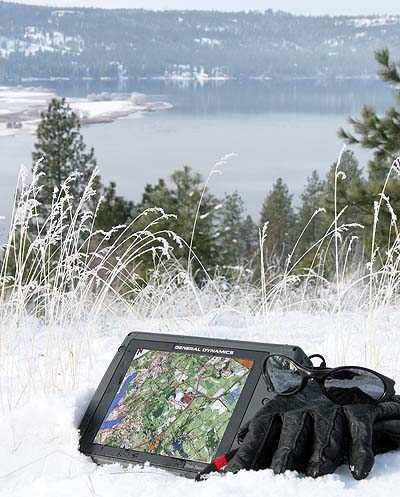 Ingress protection sealing is at the IP54 level. This means the housing is protected against dust and also against water spray from all directions. This is generally tested in accordance with procedures described in MIL-STD-810F Method 506.4 and Method 510.4.
Ingress protection sealing is at the IP54 level. This means the housing is protected against dust and also against water spray from all directions. This is generally tested in accordance with procedures described in MIL-STD-810F Method 506.4 and Method 510.4.
The Duo-Touch II also meets ASTM 4169-99 truck assurance Level II, Schedule B. ASTM stands for American Society for Testing and Materials but is now simply known as ASTM International. The D 4169 standard sets tests and requirements for strength, durability and protective capability of packaging. Level II stands for medium test intensities (Level I is highest and Level II lowest) and is most commonly used. (For some explanation, view this article in Standardization News)
Another standard the Duo-Touch II meets is MIL-STD-3009 which sets requirements for aircraft display equipment for use with night vision imaging systems. Part of this document is the U.S. Navy MIL-HDBK-87213 Revision A (Electronically/Optically Generated Airborne Displays) that describes, among other, criteria for legibility of electro-optical display equipment and daylight readability in bright environments, which is a military requirement. My assumption is that the Duo-Touch II meets both the night vision requirements (probably thanks to its highly configurable light sensor utility and a special "stealth mode" setup) as well as the contrast requirements (thanks to the DynaVue technology). It gets pretty complex tracking down all those standards and figuring out what they actually mean, so most sources on the web simply copy each other and detailed verification is not easy. General Dynamics, of course, is a major defense contractor and has supreme experience in such matters.
Yet another standard that can be important to prospective users of the Duo-Touch II covers operation in hazardous locations. GD-Itronix offers optional compliance with UL 1604 Class I, Div. 2, Group A/B/C/D. UL 1604 is a certification document by Underwriters Laboratories and covers equipment, circuits, or components intended for use in hazardous locations. This basically deals with a unit's safeguarding against causing ignition of specified flammable gas- or vapor-air mixtures.
Safety
Data safety and recovery is a major issue and becoming more so as mobile computers are becoming more widely used. The Duo-Touch II guards against unauthorized access via an integrated fingerprint scanner that covers general login, login to secure websites or password-protected applications, and also provides encryption security for individual files.
On the left side of the unit is a Kensington-compatible security slot.
There are three levels of passwords. A supervisor password protects from unauthorized critical changes in the BIOS. A user password prevents unauthorized use of the computer. A hard disk password guards against unauthorized hard disk access even if the disk is stolen and installed in another computer.
A special Stealth Mode allows management of system beeps, fan, lights, wireless radios and display for situations where light, sound or even radio signals could be dangerous.
Finally, the Duo-Touch II uses the Trusted Platform Module that provides various cryptographic capabilities including hardware-protected storage.
Wireless
GD-Itronix has always prided itself in providing superior wireless functionality and configurability. The Duo-Touch II can be equipped with a variety of integrated wireless communications modules, including Bluetooth 2.0, the Intel WiFi Link 4965AGN, GPS, as well as GSM/GPRS/EDGE/UMTS/HSDPA via AT&T Wireless (used to be Cingular) and CDMA/CDMA2000/1xRTT/EVDO via Sprint. Up to three RF modems plus GPS can be integarted into a Duo-Touch II at the same time. GD-Itronix also has a wireless carrier activation program for AT&T Wireless, Sprint and Verizon.
Docks
 Tablet computers are handy to carry around, but for full functionality you want a dock. GD-Itronix offers both a vehicle dock (left) and an office dock (right). The office dock lets you insert a Duo-Touch II computer and use it with a mouse and keyboard. The dock has two USB ports and a video port for an external monitor (maximum resolution 1280 x 1024).
Tablet computers are handy to carry around, but for full functionality you want a dock. GD-Itronix offers both a vehicle dock (left) and an office dock (right). The office dock lets you insert a Duo-Touch II computer and use it with a mouse and keyboard. The dock has two USB ports and a video port for an external monitor (maximum resolution 1280 x 1024).
Bottom line
The latest version of the GD-Itronix Tablet PC, the Duo-Touch II, represents a significant update over the earlier Duo-Touch model without straying from the basic design concept. Technology upgrades increased overall performance by 64% in our benchmarks, and the DynaVue display technology makes for very good outdoor readability. We like the dual-mode digitizer, the compact size and light weight and the many wireless configuration options in what remains an excellent computing platform choice from one of the industry's most respected and reliable vendors.
For more information, see GD-Itronix website or call 509-624-6600.
General Dynamics Itronix Duo-Touch II Specs:



